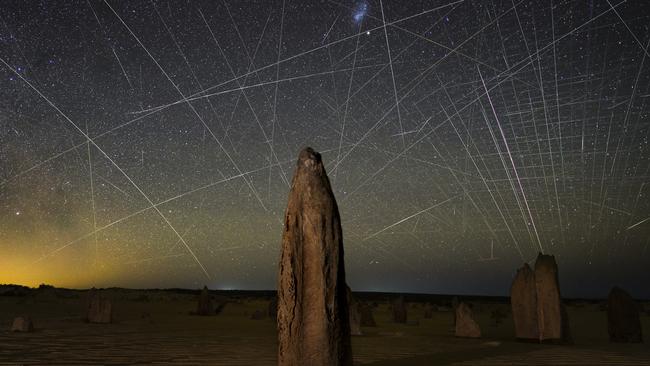Heart of the Nation: Elon Musk’s Starlink satellites above the Pinnacles
The number of satellites in Earth orbit is increasing exponentially — and they’re transforming our night skies, as this image shows.

It all started in 1957, with the Soviets’ launch of Sputnik 1. Ever since, we’ve been putting satellites into Earth’s orbit at a prodigious rate – the Union of Concerned Scientists’ database lists nearly 5000 active ones – and there’ll be tens of thousands more in the next few years as commercial ventures such as Starlink, the satellite broadband service offered by Elon Musk’s company SpaceX, hit their stride.
On a moonless night, if you’re well away from urban light pollution, many satellites are visible to the naked eye; you’ll see them as dim, moving points of light. If, as predicted, their numbers increase exponentially in coming years, what might the night sky look like? It’s an issue illustrated by this image – a finalist in the David Malin Awards, and a recent Astronomy Picture of the Day on NASA’s website – by Joshua Rozells, a 25-year-old astrophotographer from Perth. Rozells spent a night at the Pinnacles, a striking landscape of sand dunes and rock spires two hours’ drive north of the city, where he put his camera on a tripod and set it to take a continuous series of 15-second exposures, one after the other, for three hours. “In every single one of those exposures, there was at least one light trail caused by a moving satellite,” says Rozells, a devout Christian who works for WA’s Department of Communities, formulating policy for at-risk youth. He selected 343 of the exposures – about 85 minutes’ worth – and put them together in Photoshop to create this arresting composite image.
Using databases that track man-made objects in orbit, he was later able to identify many of those streaks of light. Most are Starlink satellites; but that bright, pinkish object tracing a line down to the rock spire in the right of the frame is SL-3 R/B, the defunct body of a rocket that was launched by the USSR in the early ’60s, and still laps Earth once every 100 minutes or so. Oh, and that weird yellow glow in the left of the photo? There’s a rather more prosaic explanation for that. “It’s the lights from the toilet block at the visitor’s centre,” chuckles Rozells. laughs.


To join the conversation, please log in. Don't have an account? Register
Join the conversation, you are commenting as Logout